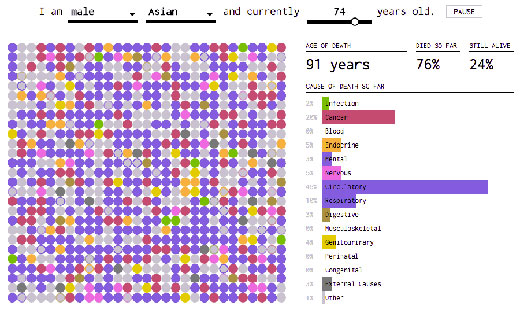當前位置: Language Tips> 雙語新聞
This interactive chart will show you when and how you're most likely to die
分享到
They say Jan. 18 — or Blue Monday — is the most depressing day of the year, but they're wrong. The most depressing day of the year is today, because you're about to find out how and when you're most likely to die.
人們總說“藍色星期一”,即1月18號那一天,是一年中心情最陰郁的日子。錯了。最郁悶的一天將是今天,因為今天你將發現自己很可能會怎么死、何時死。
Statistician Nathan Yau has created an interactive chart to determine, in his words, "how and when you will die, given your sex, race and age." Fun!
統計學家邱南森制作了一個互動圖表,他稱這個圖表將“根據年齡、種族以及年齡不同,顯示每個人在各個年紀將面臨何種威脅生命的問題”。真神奇!

To create his chart, Yau used data from the CDC's Underlying Cause of Death Database, a rather bleak collection of US death statistics from 1999 to 2014. Using information obtained from Americans' death certificates, the database catalogs deaths based on age, race, gender, year and cause of death, among other metrics.
美國疾控中心收集了1999年至2014年期間國內死亡證明上的一些信息,并統計了其中關于美國人主要死因的系列數據,結果不容樂觀。該數據庫根據年齡、種族、性別、年份、死因及其他參數將死亡情況進行分類。
Once you enter your sex, race and age, the chart will kick into motion. For each year past your current age, it'll show you how likely you are to die of various common causes of death: infection, cancer, blood, endocrine, mental, nervous, circulatory, respiratory, digestive, musculoskeletal, genitourinary, perinatal, congenital and external causes.
只要你一輸入自己的性別、種族和年齡,該圖表就開始發生相應變化。對于你今后的每一年,它都將顯示一組潛在的死因,如傳染病、癌癥、血液疾病、內分泌失調、精神疾病、神經疾病、循環系統疾病、呼吸疾病、消化疾病、肌骨失常、泌尿生殖疾病、圍產期死亡、先天性疾病及其他外因。并且,隨著年紀的改變,各死因概率會發生對應的變化。
For every year past your current age, the chart will also show you the likeliness of having died by that point.
圖表中還會顯示,你活到某一個年齡的概率有多大。
The main point, which is what you'd expect, is that mortality rate is much lower in the earlier years of life than in the older years. But, if you do die at a younger age, it's much more likely due to something external rather than a disease.
可以想見的是,相較于晚年,早年死亡率要低得多。但是,早年死亡的原因大多是外部事故,而非自身疾病。
You can also look at it the other way. Shift age to the older years, and let the simulations run. You're much more likely to die of a disease rather than something external. Shift past 80 years, and it's over 40% chance the cause will be circulatory, regardless of demographic group.
你也可以換個角度看這個問題。把年齡設定得大一些,然后讓模擬器運轉起來。隨著人們慢慢變老,死因更有可能是自身疾病,而非外部因素。不管哪類人,活至八十,死于血液循環疾病的幾率都超過40%。
I tried the chart out for myself, a 24-year-old white female. If I die two years from now, at 26, there's hardly any chance it'll be from health problems — and a very high likelihood it'll be from external causes.
我自己也嘗試了一下這個圖表。我按要求依次輸入了自己的信息:女性,白種人,24歲。圖表上顯示著:兩年后,也就是當我26歲的時候,我若是面臨著死亡,基本上可以肯定不是因為我身體不好,而罪魁禍首很有可能是意外事故。
At 50 years old, there's a 95% chance I'll still be alive — that's still pretty good! If I do happen to die at 50, it'll most likely be from circulatory problems, cancer, infection or external causes.
圖表顯示我能活到50歲的幾率高達95%,這簡直太棒了!但如果我不幸50歲的時候死了,極大可能是死于血液循環疾病、癌癥、傳染病或意外事故。
Finally, here I am at 80. Now, there's only a 52% chance I'll still be alive. If I die, the most likely causes will be circulatory, cancer and endocrine.
最后,看一下八十歲的我是怎樣的情況吧。果然,我活著的幾率減半了,只有52%,主要的死因是血液循環疾病、癌癥和內分泌失調。
Yau was surprised to see that circulatory problems — and not cancer — were such a prominent cause of death.
邱南森驚訝地發現,主要致死疾病竟然是血液循環疾病而非癌癥。
"It seems like cancer would be the leading cause, just going off general news," he wrote. "This is certainly true up to a certain age, but get past that and your heart can only keep going for so long."
他寫道:“根據各大新聞的報道,人們似乎一直認為癌癥才是頭號殺手。當人活到某個年紀,確實如此。但就算你過了這一關,你的心臟也只能再運轉這么些年。”
Try it yourself.
你也來試試吧!
點擊鏈接:http://flowingdata.com/2016/01/19/how-you-will-die/
Vocabulary
endocrine: 內分泌
circulatory problems: 循環系統問題
英文來源:雅虎
譯者:孫慧
審校&編輯:丹妮
上一篇 : 關于埃及你不知道的10件事
下一篇 : 科學家稱發現太陽系第9行星
分享到
關注和訂閱


電話:8610-84883645
傳真:8610-84883500
Email: languagetips@chinadaily.com.cn